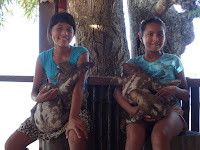So, before you book your trip to the same old tropical 'hot spot', take a look at some of these fantastic hidden gems!
Quad Biking
 Want a little adrenaline rush this tropical vacation? You've come to the right place! Rent a quad from Flying Pirates and cruise through acres of private jungle land, blast through mud pits, swim in blue lagoon, and even take a little hike to a private beach. We happen to have also seen a sloth when we went so keep your eyes open!
Want a little adrenaline rush this tropical vacation? You've come to the right place! Rent a quad from Flying Pirates and cruise through acres of private jungle land, blast through mud pits, swim in blue lagoon, and even take a little hike to a private beach. We happen to have also seen a sloth when we went so keep your eyes open!Chocolate Tours
Ok chocolate lovers, get ready to go to heaven!! There are lots of choices for this one!
Up in the Hill - if you don't want to really travel, take a quick water taxi ride to Old Bank on Bastimentos and talk about a 20 minute walk up the hill. Here they have an organic cocao farm to tour and some fantastic brownies for after too.
http://upinthehill.com/
I have not had the yummy pleasure of being on other tours, but know they are worth noting:
Green Acres Chocolate Farm - http://www.greenacreschocolatefarm.com/
Oreba Chocolate Tour - http://bocasdeltoro.travel/oreba-chocolate-tour/
Cacao Plantation Tour - https://www.hablayapanama.com/ecotourism/bocas-del-toro/cacao-plantation-tour/
Red Frog Beach
While the water can be quite rough with riptides, the beach is pristine white sand, little huts for shade, and a couple places for your tropical drinks. What more could a beach bum want?!
Bluff Beach
Playa Estralla
 Starfish beach or Playa Estralla as known here, is the best place for a relaxing afternoon, hanging out in the water with a rum coconut in your hand. Little shacks line the beach with various fish and patacones dishes for sale and some will even set up at the edge of the water for you! Today sadly, there are only a few actual starfish left at this beach because of the boats and tourists, but it is still worth a trip. To see fish and other sea life, see my Blue Coconut section!
Starfish beach or Playa Estralla as known here, is the best place for a relaxing afternoon, hanging out in the water with a rum coconut in your hand. Little shacks line the beach with various fish and patacones dishes for sale and some will even set up at the edge of the water for you! Today sadly, there are only a few actual starfish left at this beach because of the boats and tourists, but it is still worth a trip. To see fish and other sea life, see my Blue Coconut section!

Cruising the waters and islands
Whether you rent a private panga with some friends or charter one of the local catamarans, I highly suggest spending a day out on the waters, being immersed in the peace and tranquility of the islands. It truly is breathtaking to see, and this is what makes Bocas such a special place!
Zapatias
It's definitely worth a quick trip out here! They are two uninhabited islands off the tip of Isla Bastimentos with white sand beaches, fantastic snorkeling and some trails to hike.
http://www.bocas-del-toro.org/zapatillas/

The Blue Coconut
A quick water taxi from town and definitely worth a visit! The restaurant is built out over the water off a mangrove island. They feed the fish and ensure that their waters stay safe and clean for optimal snorkling, and just to plain and simply help the ecosystem. Off to the side there is also a coral reef to snorkel around, paddle boards can be rented by the hour, and there is even an over the water cabin that can be rented nightly!
Sunset from the Blue Coconut and one of their dogs Molly!

Staying outside of Bocas Town

 This is a must!!! Many people will get caught up with the comfort and convenience of town, but be assured, you haven't really experience Bocas until you get out into the other islands. To paint you an idea... I'm sitting here writing this blog, listening to parrots fly by, a slight breeze and looking out on to the tranquil waters. You will never find a better office and it's a great place to hold up in a hammock and read that book that you've been wanting to for months! You may even get to experience a bad at a local pool party or a sloth posting up for the afternoon on the deck for some sun!!
This is a must!!! Many people will get caught up with the comfort and convenience of town, but be assured, you haven't really experience Bocas until you get out into the other islands. To paint you an idea... I'm sitting here writing this blog, listening to parrots fly by, a slight breeze and looking out on to the tranquil waters. You will never find a better office and it's a great place to hold up in a hammock and read that book that you've been wanting to for months! You may even get to experience a bad at a local pool party or a sloth posting up for the afternoon on the deck for some sun!!You never know what you may see and experience...this is where the real fun happens!!!












